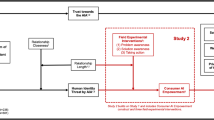Abstract
Facing the ever growing complexity and usability problems of the PC, some propose specialized computers as a solution, while others argue that such “information appliances” are unnecessary. Rather than pitting information appliances and PCs against each other, we argue instead for exploring the design space in using them together. We experimented with a device teaming approach that takes advantage of both types of devices: the familiar and high bandwidth user interface of the PC, and the task specific form factors of an information appliance. In our experimentation, we designed and developed a phone n’ computer (PnC) by teaming up an IP phone with a general-purpose PC. We outline the design space for such a combination and describe several point designs we created that distribute functions between the two devices according to their characteristics. In comparison to separately using phones and computers, our designs provide new and richer user experiences including Drop-to-Call, sharing visual information, and caller information display.






Similar content being viewed by others
References
Barton JJ, Nylander S, Folowosele F, Harrison B (2006) Dialing for displays: session initiation protocol for opportunistic augmentation. In: Proceedings fourth IEEE intl conf pervasive comp and comm, pp 60–65
Buxton W (2001) Less is more (more or less). In: Denning P (ed) The invisible future: the seamless integration of technology in everyday life. McGraw Hill, New York, pp 145–179
Dearman D, Pierce J (2008) It’s on my other computer!: Computing with multiple devices. In: Proceedings of CHI 2008: ACM Conference on Human Factors in Computing Sytesm, pp 767–776
Fox A, Johanson B, Hanrahan P, Winograd T (2000) Integrating information appliances into an interactive space. IEEE Comp Graphics Appl, 20(3):54–65
Hutchings H, Pierce J (2006) Understanding the whethers, hows, and whys of divisible interfaces. In: Proceedings of AVI 2006, pp 274–277
Johanson B, Pennekanti S, Sengupta C, Fox A (2001) Multibrowsing: moving Web content across multiple displays. In: Proceedings of Ubicomp 2001, pp 346–353
Newman M, Izadi S, Edwards WK, Sedivy J, Smith T (2002) User interfaces when and where they are needed: an infrastructure for recombinant computing. In: Proceedings of UIST 2002: ACM symposium on user interface software and technology, pp 171–180
Norman DA (1998) The invisible computer: why good products can fail, the personal computer is so complex, and information appliances are the solution. MIT Press, Cambridge
Odlyzko AM (1999) The visible problems of the invisible computer: a skeptical look at information appliances first monday
Pierce JS, Mahaney HE (2004) Opportunistic annexing for handheld devices: opportunities and challenges. In: Proceedings human–computer interaction consortium (HCIC)
Pierce J, Nichols J (2008) An infrastructure for extending applications’ user experiences across multiple personal devices. In: Proceedings of UIST 2008: ACM symposium on user interface software and technology, pp 101–110
Roman M, Hess C, Cerquiera R, Ranganathan A, Campbell R, Nahrstedt K (2002) A middleware infrastructure for active spaces. IEEE Pervas Comput 1:74–83
Schilit BN, Sengupta U (2004) Device ensembles. IEEE Comp 37(12):56–64
Tang JC, Lin J, Pierce JS, Whittaker S, Drews C (2007) Recent shortcuts: using recent interactions to support shared activities. In: Proceedings of CHI 2007: ACM conference on human factors in computing systems, pp 1263–1272
Yin M, Zhai S (2005) Dial and see: tackling the voice menu navigation problem with cross-device user experience integration. In: Proceedings UIST 2005—18th ACM symposium on user interface software and technology, 2005, ACM, pp 187–190
Acknowledgments
We thank our colleagues Jon Graham, John Tang, John Barton, Steve Ferrell, Tom Moran, Steve Cousins and Barton Smith. The work was performed when Min Yin worked at IBM Research—Almaden.
Author information
Authors and Affiliations
Corresponding author
Rights and permissions
About this article
Cite this article
Yin, M., Pierce, J. & Zhai, S. Phone n’ Computer: teaming up an information appliance with a PC. Pers Ubiquit Comput 14, 601–607 (2010). https://doi.org/10.1007/s00779-009-0251-6
Received:
Accepted:
Published:
Issue Date:
DOI: https://doi.org/10.1007/s00779-009-0251-6




